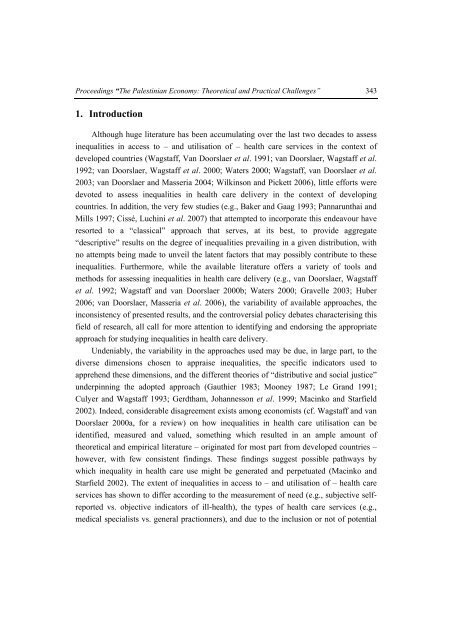The Palestinian Economy. Theoretical and Practical Challenges
The Palestinian Economy. Theoretical and Practical Challenges
The Palestinian Economy. Theoretical and Practical Challenges
Create successful ePaper yourself
Turn your PDF publications into a flip-book with our unique Google optimized e-Paper software.
Proceedings “<strong>The</strong> <strong>Palestinian</strong> <strong>Economy</strong>: <strong>The</strong>oretical <strong>and</strong> <strong>Practical</strong> <strong>Challenges</strong>” 343<br />
1. Introduction<br />
Although huge literature has been accumulating over the last two decades to assess<br />
inequalities in access to – <strong>and</strong> utilisation of – health care services in the context of<br />
developed countries (Wagstaff, Van Doorslaer et al. 1991; van Doorslaer, Wagstaff et al.<br />
1992; van Doorslaer, Wagstaff et al. 2000; Waters 2000; Wagstaff, van Doorslaer et al.<br />
2003; van Doorslaer <strong>and</strong> Masseria 2004; Wilkinson <strong>and</strong> Pickett 2006), little efforts were<br />
devoted to assess inequalities in health care delivery in the context of developing<br />
countries. In addition, the very few studies (e.g., Baker <strong>and</strong> Gaag 1993; Pannarunthai <strong>and</strong><br />
Mills 1997; Cissé, Luchini et al. 2007) that attempted to incorporate this endeavour have<br />
resorted to a “classical” approach that serves, at its best, to provide aggregate<br />
“descriptive” results on the degree of inequalities prevailing in a given distribution, with<br />
no attempts being made to unveil the latent factors that may possibly contribute to these<br />
inequalities. Furthermore, while the available literature offers a variety of tools <strong>and</strong><br />
methods for assessing inequalities in health care delivery (e.g., van Doorslaer, Wagstaff<br />
et al. 1992; Wagstaff <strong>and</strong> van Doorslaer 2000b; Waters 2000; Gravelle 2003; Huber<br />
2006; van Doorslaer, Masseria et al. 2006), the variability of available approaches, the<br />
inconsistency of presented results, <strong>and</strong> the controversial policy debates characterising this<br />
field of research, all call for more attention to identifying <strong>and</strong> endorsing the appropriate<br />
approach for studying inequalities in health care delivery.<br />
Undeniably, the variability in the approaches used may be due, in large part, to the<br />
diverse dimensions chosen to appraise inequalities, the specific indicators used to<br />
apprehend these dimensions, <strong>and</strong> the different theories of “distributive <strong>and</strong> social justice”<br />
underpinning the adopted approach (Gauthier 1983; Mooney 1987; Le Gr<strong>and</strong> 1991;<br />
Culyer <strong>and</strong> Wagstaff 1993; Gerdtham, Johannesson et al. 1999; Macinko <strong>and</strong> Starfield<br />
2002). Indeed, considerable disagreement exists among economists (cf. Wagstaff <strong>and</strong> van<br />
Doorslaer 2000a, for a review) on how inequalities in health care utilisation can be<br />
identified, measured <strong>and</strong> valued, something which resulted in an ample amount of<br />
theoretical <strong>and</strong> empirical literature – originated for most part from developed countries –<br />
however, with few consistent findings. <strong>The</strong>se findings suggest possible pathways by<br />
which inequality in health care use might be generated <strong>and</strong> perpetuated (Macinko <strong>and</strong><br />
Starfield 2002). <strong>The</strong> extent of inequalities in access to – <strong>and</strong> utilisation of – health care<br />
services has shown to differ according to the measurement of need (e.g., subjective selfreported<br />
vs. objective indicators of ill-health), the types of health care services (e.g.,<br />
medical specialists vs. general practionners), <strong>and</strong> due to the inclusion or not of potential
















